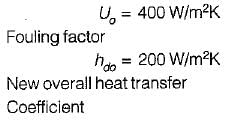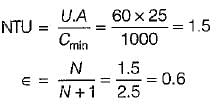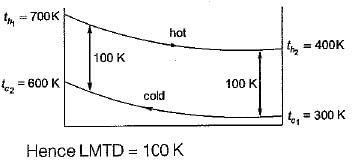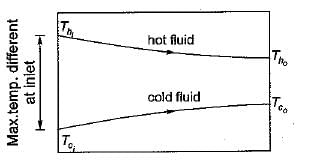Heat Exchanger - 2 - Mechanical Engineering MCQ
10 Questions MCQ Test Heat Transfer - Heat Exchanger - 2
A heat exchanger with heat transfer surface area A and overall heat transfer coefficient U handles two fluids of heat capacities Cmax and Cmin. The parameter NTU (Number of transfer units) used in the analysis of heat exchanger is defined as
The equation of effectiveness ε = 1 - e-NTU for a heat exchanger is valid in the case of
| 1 Crore+ students have signed up on EduRev. Have you? Download the App |
The overall heat transfer coefficient for a shell and tube heat exchanger for clean surfaces is Uo = 400 W/m2K. The fouling factor after one year of operation is found to be hdo = 2000 W/m2K. The overall heat transfer coefficient at this time is
A solar assisted air conditioning system, 1 kg/sec of ambient air is to be preheated by the same amount of air leaving the system. A counter-flow heat exchanger having an area of 60 m2 with overall heat transfer coefficient of 25 W/m2K is used for this purpose. Assuming cp for air is 1 kJ/kgK. The effectiveness of the heat exchanger is
Hot air enters a single pass counter flow heat exchanger at 700 K and leaves at 400 K the cooling water enters at 300 K and leaves at 600 K. The LMTD for the heat exchanger is
For the same inlet and outlet temperatures of hot and cold fluid, the LMTD is
Which one of the following graphs, showing temperature distributions of different heat exchangers, pertains steam condenser
In which type of heat exchanger is the inlet temperature difference between the hot and cold fluids is maximum
In a counter flow heat exchanger, the product of specific heat and mass flow rate is same for the hot and cold fluids. If NTU is equal to 0.5 then the effectiveness of the heat exchanger is
When tc1 and tc2 are the temperatures of cold fluid at entry and exit respectively and th1 and th2 are the temperature of hot fluid at entry and exit point and cold fluid has lower heat capacity rate as compared to hot fluid then effectiveness of the heat exchanger is given by
|
57 videos|77 docs|86 tests
|
|
57 videos|77 docs|86 tests
|























